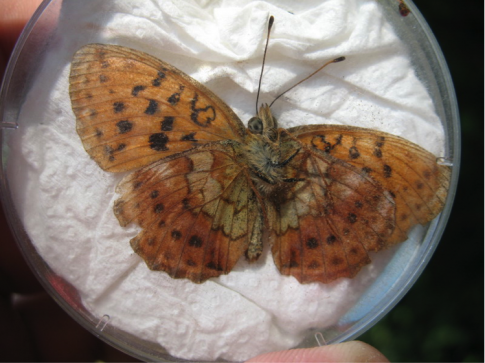News
2012-10-05
Bioindicators : butterflies
Corridors ensuring the safety of high-voltage lines play an important role for many species of butterflies that find host plants, food plants, look out territories or use it as a mean of dispersal to reach new sites
Rhopalocera, or daytime butterflies, are one of the groups in which the focus is to assess the relevance of the management / restoration in the LIFE ELIA project. Corridors ensuring the safety of high-voltage lines play an important role for many species of butterflies that find host plants, food plants, look out territories or use it as a mean of dispersal to reach new sites .
The relevance of monitoring this group is further strengthened by the fact that some habitats present in the lines (moors, bogs, ...) potentially host specialized species, which are more at risk than others. To assess the relevance of the actions implemented in the framework of the LIFE ELIA, inventories at time 0 were made during the summer of 2012 on 11 of the 15 areas of work of the project.
The butterflies were followed according to the method of transects surveyed by a team of two people walking across the width of the forest corridor under high voltage lines over a distance of 100 m.
Sixty-eight transects were inventoried in 2012, located in different habitat types: from barren bogs habitat to much more common places (common bracken or purple moor grass). During the years in which the LIFE project will take place (till 2016), these transects will be visited twice a year: once in spring and once in summer.
What have we found in 2012?
Of the 68 transects, 4 haven't delivered any butterflies but overall few species were observed by transect: the maximum (11 sp) was achieved on a site area of Durbuy. In total, 34 species were identified in the field. The species most frequently encountered are, in descending order, the Ringlet (Aphantopus hyperantus), the meadow Brown (Maniola jurtina) and the small skipper (Thymelicus sylvestris). Among the notable species encountered, always in low numbers and in a few sites, were the dark green fritillary (Argynnis aglaja) (4 sites), high brown fritillary (Argynnis adippe) (1 site) or spotted fritillary (Melitaea diamina) (1 site). One of the most interesting observations is probably the marbled fritillary (Brenthis daphne), a species found in the Walloon region for the first time in 2006 and it rapidly expanded in the area. Two individuals have been observed in the north line of Domain Epioux (Chiny wood). For more information on this species and the map distribution, see: http://biodiversite.wallonie.be/fr/brenthis-daphne.html?IDC=276&IDD=50334625

Marbled fritillary
Also note that nicely numbered populations of two rare species were observed on calcareous grasslands near Couvin: the black haistreak (Satyrium pruni) and pearly heath (Coenonympha Arcania)!

Black halstreak
In general, the relatively low number of species can probably be explained by the late period inventory, weather conditions and the fact that there was only one inventory. Locally, the presence of a significant number of bracken lines induces a trivialization of flora and thus a depletion of butterfly communities. Thus a great challenge for our project is to make the areas under high-voltage lines more welcoming for flora and fauna




